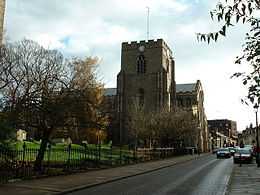St. Mary's Church, Bury St. Edmunds
| St Mary's Church, Bury St. Edmunds | |
|---|---|
 | |
| Basic information | |
| Location | Bury St Edmunds, England |
| Affiliation | Anglican |
| Ecclesiastical or organizational status | parish church |
| Website | http://www.stmarystpeter.net/stmaryschurch/ |
| Architectural description | |
| Architectural style | Decorated/Gothic |
| Specifications | |
| Capacity | 1,000+ |
St Mary's Church is the civic church of Bury St Edmunds and claims to be the third largest parish church in England.[1] It was part of the abbey complex and originally was one of three large churches in the town (the others being St James, now St Edmundsbury Cathedral, and St Margaret's, now gone).
History
The present church is the second building to stand on the site, the first being built in the 12th century by Mr Hervey. However, nothing survives of the Norman church and the oldest part of the existing building is the decorated chancel (c. 1290). There was a major renovation between the 14th and 16th centuries and it is at this point that the nave, its aisles and the tower were built. It is also at this time that Mary Tudor, favourite sister of Henry VIII, died and was buried in the church. Her tomb is in the sanctuary directly to the north of the high altar. The church, however, is dedicated to Mary, the mother of Jesus, and not, as some mistakenly believe, to Mary Tudor.
During the 16th century, John Notyngham and Jankyn Smyth, two wealthy benefactors to the church, died and left generous amounts of money to the church. These funds contributed to building the north and south quire aisles, now the Lady Chapel and Suffolk Regimental chapel, two chantry chapels and a north and south porch. The south porch was removed during a restoration in 1830s, and St Wolstan's chapel was added on the north-west side. The interior has been updated with modern utilities since then as well.
Choir
St Mary's has a traditional Anglican choir of boys and gentlemen, and has a long choral tradition spanning 600 years, which remained untouched even during Puritan times. The choir has toured to Spain, Turkey, Cyprus, Israel and Malta, and offers regular evensongs at cathedrals including Canterbury and St Paul's.
Organs and organists
The main organ is a four-manual instrument with 74 speaking stops. A second organ, a chamber organ, has four stops and is ideal as a continuo instrument where the main organ would be inappropriate. More details of the organs can be found at the National Pipe Organ Register. The current director of music is Peter Tryon, former organ scholar of Winchester Cathedral. The assistant director of music is Adrian Marple, former organ scholar of Hatfield College, Durham.
List of organists
- Ralph Guest 1796–1822
- Robert Nunn 1822–1863
- A. Lease 1863–1864
- Thomas Bentick Richardson 1864–1893
- Mr Kingston 1893–1896
- George W. Boutell 1897–1909
- Edward Percy Hallam 1909–1937
- Clifton C. Day 1937–1942
- Dr Adcock 1942–1948
- Norman H. Jones 1948–1969
- John Fear 1969–1980
- David Ivory 1980–1982
- Peter Tryon 1983–
Other burials
- Robert Drury (speaker) and his wife Anne Calthorpe
- Nicholas Clagett the elder
References
- ↑ "Welcome to St Mary's Church". St Mary's with St Peter's, Bury St Edmunds. Retrieved 2010-09-16.